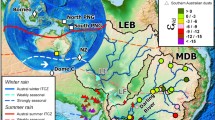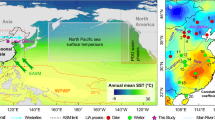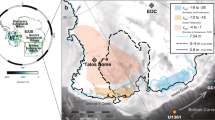Abstract
Previously published results suggest that the strength of the SW Indian Monsoon can vary significantly on century- to millenium time scales, an observation that has important implications for assessments of future climate and hydrologic change over densely populated portions of Asia. We present new, well-dated, multi-proxy records of past monsoon variation from three separate Arabian Sea sediment cores that span the last glacial maximum to late-Holocene. To a large extent, these records confirm earlier published suggestions that the monsoon strengthened in a series of abrupt events over the last deglaciation. However, our data provide a somewhat refined picture of when these events took place, and suggest the primacy of two abrupt increases in monsoon intensity, one between 13 and 12.5 ka, and the other between 10 and 9.5 ka. This conclusion is supported by the comparisons between our new marine data and published paleoclimatic records throughout the African-Asian monsoon region. The comparison of data sets further supports the assertion that maximum monsoon intensity lagged peak insolation forcing by about 3000 years, and extended from about 9.5 to 5.5 ka. The episodes of rapid monsoon intensification coincided with major shifts in North Atlantic-European surface temperatures and ice-sheet extent. This coincidence, coupled with new climate model experiments, suggests that the large land-sea thermal gradient needed to drive strong monsoons developed only after glacial conditions upstream of, and on, the Tibetan Plateau receded (cold North Atlantic sea-surface temperatures, European ice-sheets, and extensive Asian snow cover). It is likely that abrupt changes in seasonal soil hydrology were as important to past monsoon forcing as were abrupt snow-related changes in regional albedo. Our analysis suggests that the monsoon responded more linearly to insolation forcing after the disappearance of glacial boundary conditions, decreasing gradually after about 6 ka. Our data also support the possibility that significant century-scale decreases in monsoon intensity took place during the early to mid-Holocene period of enhanced monsoon strength, further highlighting the need to understand paleomonsoon dynamics before accurate assessments of future monsoon strength can be made.
Similar content being viewed by others
References
Adamson DA, Gasse F, Street FA, Williams MAJ (1980) Late Quaternary history of the Nile. Nature 287:50–55
An Z, Porter SC, Weijian Z, Yanchou L, Donahue DJ, Head MJ, Xihuo W, Jianzhang R, Hongbo Z (1993) Episode of strengthened summer monsoon climate of Younger Dryas Age on the loess plateau of Central China. Quat Res 39:45–54
Anderson DM (1993) A 300 KYR record of upwelling off Oman-during the Late Quaternary: evidence of the Asian Southwest Monsoon. Paleoceanography 8:(2) 193–208
Anderson DM, Prell WL (1992) The structure of the southwest monsoon winds over the Arabian Sea during the Late Quaternary: observations, simulations, and marine geologic evidence. J Geophys Res 97:15481–15487
Anderson DM, Prell WL (1993) A 300 Kyr record of upwelling off Oman during the late Quaternary: evidence of the Asian Southwest Monsoon. Paleoceanography 8:193–208
Anderson DM, Brock JC, Prell WL (1992) Physical upwelling processes, upper ocean environment and the sediment record of the southwest monsoon. Geol Soc Spec Publ 64:121–129
Atkinson TC, Briffa KR, Coope GR (1987) Seasonal temperatures in Britain during the past 22000 years, reconstructed using beetle remains. Nature 325:587–592
Bard E, Arnold M, Maurice P, Duprat J, Moyes J, Duplessy JC (1987) Retreat velocity of the North Atlantic polar front during the last deglaciation determined by C14 accelerator mass spectrometry. Nature 328:791–794
Bard E, Hamelin B, Fairbanks RG, Zindler A (1990) Calibration of the 14C timescale over the past 30000 years using mass spectrometric U-Th ages from Barbados corals. Nature 345:(6274) 405–410
Barnett TP, Domenil L, Schlese U, Roeckner E (1988) The effect of Eurasian snow cover on global climate. Science 239:504–507
Barnett TP, Dumenil L, Schlese U, Roeckner E, Latif M (1989) The effect of Eurasian snow cover on regional and global climate variations. J Atmos Sci 46:(5) 661–684
Barnola JM, Raynaud D, Korotkevich YS, Lorius C (1987) Vostok ice core provides 160000-year record of atmospheric CO2. Nature 329:408–414
Berger A, Loutre MF (1991) Insolation values for the climate of the last 10 million years. Quat Sci Rev 10:297–317
Birks HH (1991) Holocene vegetational history and climatic change in west Spitsbergen — plant macrofossils from Skardtjorna, an Arctic lake. The Holocene 1:209–218
Bonnefille R, Riollet G, Buchet G (1991) Nouvelle Sequence pollinique d'une tourbiere de la crete Zaire-Nil (Burundi). Rev Palaeobot Palynol 67:315–330
Broecker WS (1987) Unpleasant surprises in the greenhouse? Nature 328:123–126
Broecker WS, Andree M, Wolfli W, Oeschger H, Bonani G, Kennett J, Peteet D (1988) The chronology of the last deglaciation: implications to the cause of the Younger Dryas event. Paleoceanography 3:1–19
Broecker WS, Denton GH (1989) The role of ocean-atmosphere reorganizations in glacial cycles. Geochim Cosmochim Acta 53:2465–2501
Bryson RA (1989) Modelling the NW India monsoon for the last 40000 years. Clim Dyn 3:169–177
Bryson RA, Swain AM (1981) Holocene variations of monsoon rainfall in Rajasthan. Quat Res 16:135–145
Chappellaz J, Barnola JM, Raynaud D, Korotkevich YS, Lorius C (1990) Ice-core record of atmospheric methane over the past 160000 years. Nature 345:(6271) 127–131
Clark ID, Fontes J (1990) Paleoclimatic reconstruction in northern Oman based on carbonates from hyperalkaline groundwaters. Quat Res 33:320–336
Clemens SC, Prell WL (1990) Late Pleistocene variability of Arabian Sea summer monsoon winds and continental aridity: eolian records from the lithogeniccomponent of deep-sea sediments. Paleoceanography 5:(2) 109–145
Clemens SC, Prell WL (1991) Late Quaternary forcing of Indian Ocean summer-monsoon winds: A comparison of fourier model and general circulation model results. J Geophys Res 96: (D12) 22683–22700
Clemens SC, Oglesby RJ (1990) Interhemispheric moisture transport in the Indian Ocean summer monsoon: data-model and model-model comparisons. Paleoceanography 7:(5) 633–643
Clemens S, Prell W, Murray D, Shimmield G, Weedon G (1991) Forcing mechanisms of the Indian Ocean monsoon. Nature 353:720–725
COHMAP Members (1988) Climatic changes of the last 18000 years: observations and model simulations. Science 241:1043–1052
CLIMAP Project Members (1981) Seasonal reconstruction of the Earth's surface at the last glacial maximum. Geol Soc Am Map Chart Ser MC-36
deMenocal PB, Rind D (1993) Sensitivity of Asian and African climate to variations in seasonal insolation, glacial ice cover, sea surface temperature, and Asian orography. J Geophys Res 98:7265–7288
Denton G, Hughes T (eds) (1981) The last great ice sheets. Wiley, New York
Dickson RR (1984) Eurasian snow cover versus Indian monsoon rainfall — An extension of the Hahn-Shukla results. J Clim App Meteorol 23:171–173
Duplessy JC (1982) Glacial to interglacial contrasts in the northern Indian Ocean. Nature 295:494–498
Duplessy JC, Delibrias G, Turon JL, Pujol C, Duprat J (1981) Deglacial warming of the northeastern Atlantic Ocean: correlation with the paleoclimatic evolution of the European continent. Palaeogeog Palaeoclim Palaeoecol 35:121–144
Fang J (1991) Lake evolution during the past 30 000 years in China, and its implications for environmental change. Quat Res 36:37–60
Fein JS, Stephens PL (eds) (1987) Monsoons. John Wiley, New York
Gasse F, Street FA (1978) Late Quaternary lake-level fluctuations and environments of the northern Rift Valley and Afar region (Ethiopia and Djibouti). Palaeogeogr Palaeoclim Palaeoecol 24:279–325
Gasse F, Van Campo E (1994) Abrupt post-glacial climte events in West Asia and North Africa monsoon domains. Earth Planet Sci Lett 126:435–456
Gasse F, Ledee V, Massault M, Fontes J (1989) Water-level fluctuations of Lake Tanganyika in phase with oceanic changes during the last glaciation and deglaciation. Nature 342:(6245) 57–59
Gasse F, 12 others (1991) A 13000-year climate record from western Tibet. Nature 353:742–745
Gillespie R, Street-Perrott FA, Switsur R (1983) Post-glacial arid episodes in Ethiopia have implications for climate prediction. Nature 306:680–683
Haberyan KA (1987) Fossil diatoms and the paleolimnology of Lake Rukwa, Tanzania. Freshwater Biol 17:429–436
Haberyan KA, Hecky RE (1987) The late Pleistocene and Holocene stratigraphy and paleolimnology of Lakes Kivu and Tanganyika. Palaeogeog Palaeoclim Palaeoecol 61:169–197
Hansen J, Russell G, Rind D, Stone P, Lacis A, Ledeff S, Reudy R, Travis L (1983) Efficient three-dimensional global models for climate studies: Models I and II. Mon Weather Rev 111:609–662
Hastenrath S (1991) Climate dynamics of the Tropics. Kluwer Academic Publishers, Dordrecht
Houghton JT, Callander BA, Varney SK (1992) Climate Change 1992: The Supplementary Report to the IPCC Scientific Assessment, Cambridge University Press, Cambridge, UK
Jarvis DI (1993) Pollen evidence of changing holocene monsoon climate in Sichuan Province, China. Quat Res 39:325–337
Karpuz NK, Jansen E (1992) A high-resolution diatom record of the last deglaciation from the SE Norwegian Sea: documentation of rapid climatic changes. Paleoceanography 7:(4) 499–520
Koç N, Jansen E, Haflidason H (1993) Paleoceanographic reconstructions of surface ocean conditions in the Greenland, Iceland and Norwegian Seas through the last 14 ka based on diatoms. Quat Sci Rev 12:115–140
Kropelin S, Soulie-Marsche I (1991) Charophyte remains from Wadi Hower as evidence for deep Mid-Holocene freshwater lakes in the Eastern Sahara of Northwest Sudan. Quat Res 36:210–223
Kutzbach JE (1981) Monsoon climate of the early Holocene, climatic experiment using the earth's orbital parameters for 9000 years ago. Science 214:59–61
Kutzbach JE (1987) The changing pulse of the Monsoon. In: Fein JS, Stephens PL (eds) Monsoon 247–268. John Wiley, New York
Kutzbach JE, Street-Perrott FA (1985) Milankovitch forcing of fluctuations in the level of tropical lakes from 18 to 0 kyr BP. Nature 317:130–134
Lamb HF, Gasse F, Benkaddour A, El Hamouti N, van der Kaars S, Perkins WT, Pearce NJ, Roberts CN (1995) Relation between century-scale Holocene arid intervals in tropical and temperate zones. Nature 373:134–137
Lean J, Rind D (1994) Solar variability: Implications for global change. EOS. Trans Am Geophys Union 75:5–7
Lean J, Skumanich A, White O (1992) Estimating the Sun's radiative output during the Maunder Minimum. Geophys Res Lett 19:1591–1594
Lehman SJ, Forman SL (1992) Late Weichselian glacier retreat in Kongsfjorden, West Spitsbergen, Svalbard. Quat Res 37:139–154
Lehman SJ, Keigwin LD (1992) Sudden changes in North Atlantic circulation during the last deglaciation. Nature 56:757–762
Manabe S, Broccoli AJ (1985) The influence of continental ice sheets on the climate of an ice age. J Geophys Res 90:2167–2190
Manabe S, Stouffer RJ (1988) Two stable equilibria of a coupled ocean-atmosphere model. J Clim 1:841–866
McClure HA (1976) Radiocarbon chronology of late Quaternary lakes in the Arabian Desert. Nature 263:755–756
Meehl GA (1994) Influence of the land surface in the Asian summer monsoon: external conditions versus internal feedbacks. J Clim 7:1033–1049
Meehl GA, Washington WM (1993) South Asian summer monsoon variability in a model with doubled atmospheric carbon dioxide concentrations. Science 260:1101–1103
Overpeck JT (1991) Century-to millennium-scale climatic variability during the late Quaternary. In: Global changes of the past. Bradley R (ed) UCAR/Office for Interdisciplinary Earth Studies, Boulder, CO, pp 139–173
Overpeck JT (1993) The role and response of continental vegetation in the global climate system, In: Global changes in the perspective of the past. Eddy JA, Oeschger H (eds), J. Wiley, New York, pp 221–238
Overpeck JT, Peterson LC, Kipp N, Imbrie J, Rind D (1989) Climate change in the circum-North Atlantic region during the last deglaciation. Nature 338:553–557
Owen RB, Barthelme JW, Renaut RW, Vincens A (1982) Palaeolimnology and archaeology of Holocene deposits northeast of Lake Turkana, Kenya. Nature 298:523–529
Pachur HJ, Kröpelin S (1987) Wadi Howar: paleoclimatic evidence from an extint river system in the southeastern Sahara. Science 237:298–300
Pachur H, Hoelzmann P (1991) Paleoclimatic implications of late Quaternary lacustrine sediments in western Nubia, Sudan. Quat Res 36:257–276
Paillard D, Labeyrie L (1994) Role of the thermohaline circulation in the abrupt warming after Heinrich events. Nature 372:162–164
Peterson LC, Overpeck JT, Kipp NG, Imbrie J (1991) A high resolution late Quaternary upwelling record from the anoxic Cariaco Basin, Venezuela. Pale oceanography 6:99–119
Porter SC, An Z, Zheng H (1992) Cyclic Quaternary alluviation and terracing in a nonglaciated drainage basin on the north flank of the Qinling Shan, central China. Quat Res 38:157–169
Prell WL (1984) Variations of monsoonal upwelling: a response to changing solar radiation. In: Hansen JE, Takahashi T (eds) Climate processes and Climate sensitivity. Geophysical Monograph 29.48–57. Washington, D.C.: American Geophysical Union
Prell WL, Kutzbach JE (1987) Monsoon variability over the past 150000 years. J Geophys Res 82:8411–8425
Prell WL, Kutzbach JE (1992) Sensitivity of the Indian monsoon to forcing parameters and implications for its evolution. Nature 360:647–652
Prell WL, Van Campo E (1986) Coherent response of Arabian Sea upwelling and pollen transport to late Quaternary monsoonal winds. Nature 323:526–528
Prell WL, Marvil RE, Luther ME (1990) Variability in upwelling fields in the northwestern Indian Ocean 2. data-model comparison at 9000 years B.P. Paleoceanography 5:(3) 447–457
Rind D, Overpeck J (1993) Hypothesized causes of decade-to century-scale climate variability: climate model results. Quat Sci Rev 12:357–374
Rind D, Peteet D, Broecker WS, McIntyre A, Ruddiman WF (1986) Impact of cold North Atlantic sea surface temperatures on climate: implications for the Younger Dryas cooling (11–10k). Clim Dyn 1:3–33
Ritchie JC (1987) A Holocene pollen record from Bir Atrun, Northwest Sudan. Pollen Spores 29:(4) 391–410
Ritchie JC (1994) Holocene pollen spectra from Oyo, northwestern Sudan: problems of interpretation in a hyperarid environment. The Holocene 4:(1) 9–15
Ritchie JC, Haynes CV (1987) Holocene vegetation zonation in the eastern Sahara. Nature 330:(6149) 645–647
Ritchie JC, Eyles CH, Haynes CV (1985) Sediment and pollen evidence for an early to mid-Holocene humid period in the eastern Sahara. Nature 314:352–355
Roberts N, Taieb M, Barker P, Damnatl B, Icole M, Williamson D (1993) Timing of the Younger Dryas event in East Africa from lake-level changes. Nature 366:146–148
Ruddiman WF (1987) Northern oceans. In: Ruddiman WF, Wright HE ed. The geology of North America, K-3. The Geological Society of America, Boulder pp 137–154
Singh G, Wasson RJ, Agrawal DP (1990) Vegetational and seasonal climatic changes since the last full glacial in the Thar Desert, northwestern India. Rev Palaeobot Palynol 64:351–358
Sirocko F, Sarnthein M, Lange H, Erlenkeuser H (1991) Atmospheric summer circulation and coastal upwelling in the Arabian Sea during the Holocene and the last glaciation. Quat Res 36:72–93
Sirocko F, Sarnthein M, Erlenkeuser H, Lang H, Arnold M, Duplessy JC (1993) Century-scale events in monsoonal climate over the past 24000 years. Nature 364:322–324
Stager JC (1988) Environmental changes at Lake Cheshi, Zambia since 40000 Years BP. Quat Res 29:54–65
Stocker TF, Wright DG (1991) Rapid transitions of the ocean's deep circulation induced by changes in surface water fluxes. Nature 351:729–732
Street-Perrott FA, Roberts N (1983) fluctuations in closed-basin lakes as an indicator of past atmospheric circulation patterns. In: Street-Perrott A, Beran M, Ratcliffe R (eds) Variations in the global water budget. D. Reidel, Dordrecht, 331–345
Street-Perrott FA, Perrott RA (1990) Abrupt climate fluctuations in the tropics: the influence of Atlantic Ocean circulation. Nature 343:607–612
Street-Perrott FA, Mitchell JFB, Marchand DS, Brunner JS (1990) Milankovitch and albedo forcing of the tropical monsoons: a comparison of geological evidence and numerical simulations for 9000 yrs BP. Trans R Soc Edinburgh Earth Sci 81:407–427
Svendsen JI, Mangerud J (1992) Paleoclimatic inferences from glacial fluctuations on Svalbard during the last 20000 years. Clim Dyn 6:213–220
Swain AM, Kutzbach JE, Hastenrath S (1983) Estimates of Holocene precipitation for Rajesthan, India, based on pollen and lake-level data. Quat Res 19:1–17
Taylor DM (1990) Late Quaternary pollen records from two Ugandan mires: evidence for environmental change in the Rukia Highlands of southwest Uganda. Palaeogeog Palaeoclimatol Palaeoecol 80:283–300
Van Campo E, Gasse F (1993) Pollen- and diatom-inferred climatic and hydrological changes in Sumxi Co Basin (western Tibet) since 13 000 yr BP. Quat Res 39:300–313
Van Campo E, Duplessy JC, Rossignol-Strick M (1982) Climatic conditions deduced from a 150 Kyr oxygen isotope-pollen record from the Arabian Sea. Nature 296:56–59
Vincens A (1989) Paleoenvironnements du bassin nord-Tanganyika (Zaire, Burundi, Tanzanie) an tours des 13 derniers mille ans: apport de la palynologie. Rev Palaeobot Palynol 61:69–88
Vincens A (1991) Late Quaternary vegetation history of the South-Tanganyika Basin. Climate implications in South Central Africa. Palaeogeog Palaeoclimatol Palaeoecol 86:207–226
Wang F, Fan CY (1987) Climatic changes in the Qinghai-Xizang (Tibetan) region of China during the Holocene. Quat Res 28:50–60
White JWC, Ciais P, Figge RA, Kenny R, Markgraf V (1994) A high-resolution record of atmospheric CO2 content from carbon isotopes in peat. Nature 367:153–156
Winkler M, Wang PK (1993) The late-Quaternary vegetation and climate of China. In: Wright HE Jr, Kutzbach JE, Webb T III, Ruddiman WF, Street-Perrott FA, Bartlein PJ (eds) Global climate since the Last Glacial Maximum. University of Minnesota Press, Minneapolis, pp 221–261
Zielinski GA, Mayewski PA, Meeker LD, Whitlow S, Twickler MS, Morrison M, Meese DA, Gow AJ, Alley RB (1994) Records of volcanism since 7000 B.C. from the GISP2 Greenland ice core and implications for the volcano-climate system. Science 264:948–952
Author information
Authors and Affiliations
Rights and permissions
About this article
Cite this article
Overpeck, J., Anderson, D., Trumbore, S. et al. The southwest Indian Monsoon over the last 18 000 years. Climate Dynamics 12, 213–225 (1996). https://doi.org/10.1007/BF00211619
Received:
Accepted:
Issue Date:
DOI: https://doi.org/10.1007/BF00211619




